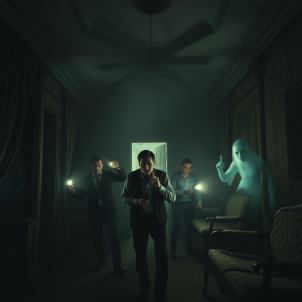
The concept of demonic possession has been a topic of fascination and terror for centuries, with countless tales of individuals being taken over by malevolent entities from beyond the veil. While many dismiss such claims as mere fantasy or the result of mental illness, there are certain cases that defy explanation and continue to unsettle even the most skeptical of minds.
One of the most notorious cases of alleged demonic possession is that of Roland Doe, a 14-year-old boy from Maryland who in 1949 became the subject of a horrific and well-documented case of possession. The boy, who was later identified as “Ronald Hunkeler,” began exhibiting strange and terrifying behaviors, including unexplained noises, furniture moving on its own, and a deep, raspy voice that seemed to emanate from his mouth.
As the possession progressed, Ronald’s behavior became increasingly erratic and violent, with reports of him speaking in tongues, levitating above his bed, and even attacking those around him. Despite the efforts of local priests and clergy, the possession only seemed to intensify, with Ronald eventually undergoing a series of exorcisms that would become one of the most famous and well-documented cases in history.
The exorcisms, which were performed by Catholic priests William Bowdern and Edward Hughes, were said to be incredibly intense, with reports of Ronald’s body contorting into impossible positions, his voice booming with an otherworldly fury, and even the presence of a foul, sulfurous odor that seemed to permeate the air. While the exorcisms ultimately seemed to be successful in freeing Ronald from the grip of the demon, the case remains one of the most chilling and well-documented examples of demonic possession on record.
Another case that continues to send shivers down the spines of even the most hardened skeptics is that of Anneliese Michel, a young German woman who in 1976 died as a result of a series of exorcisms performed by Catholic priests. Anneliese, who had a history of mental illness and had been experiencing strange and terrifying visions, became convinced that she was possessed by a demon and begged her family and clergy to perform an exorcism.
Despite the warnings of medical professionals, who believed that Anneliese’s condition was the result of a psychological disorder rather than demonic possession, the exorcisms went ahead, with disastrous consequences. Over the course of several months, Anneliese was subjected to a total of 67 exorcisms, during which she was reportedly forced to consume a diet of bread and water, was bound to her bed, and was repeatedly subjected to physical and emotional abuse.
As the exorcisms progressed, Anneliese’s condition deteriorated rapidly, with reports of her becoming increasingly frail, her body covered in bruises and welts, and her mind descending into madness. Despite the efforts of her family and clergy to save her, Anneliese eventually died of starvation and exhaustion, her body weighing a mere 68 pounds at the time of her death.
The case of Anneliese Michel is a stark reminder of the dangers of misdiagnosing mental illness as demonic possession, and the devastating consequences that can result from such a mistake. While the Catholic Church has since acknowledged that the exorcisms were a mistake and that Anneliese’s condition was the result of a psychological disorder, the case remains a haunting and unsettling reminder of the blurred lines between faith and madness.
In recent years, there have been a number of high-profile cases of alleged demonic possession, including that of the “Watseka Wonder,” a 13-year-old girl from Illinois who in 1878 became the subject of a well-documented case of possession. The girl, who was identified as “Lurancy Vennum,” began exhibiting strange and terrifying behaviors, including unexplained noises, furniture moving on its own, and a deep, raspy voice that seemed to emanate from her mouth.
As the possession progressed, Lurancy’s behavior became increasingly erratic and violent, with reports of her speaking in tongues, levitating above her bed, and even attacking those around her. Despite the efforts of local clergy and spiritualists, the possession only seemed to intensify, with Lurancy eventually undergoing a series of exorcisms that would become one of the most famous and well-documented cases in history.
While the case of the Watseka Wonder is often cited as one of the most convincing examples of demonic possession on record, it is worth noting that the case has been the subject of much debate and controversy, with many experts questioning the validity of the claims and suggesting that Lurancy’s behavior may have been the result of a psychological disorder or a hoax.
In conclusion, the concept of demonic possession remains a topic of fascination and terror, with countless tales of individuals being taken over by malevolent entities from beyond the veil. While many of these cases can be explained away by mental illness or misdiagnosis, there are certain cases that defy explanation and continue to unsettle even the most skeptical of minds. Whether or not one believes in the existence of demonic possession, it is undeniable that these cases are a stark reminder of the darker aspects of human nature and the devastating consequences that can result from the blurring of lines between faith and madness.


